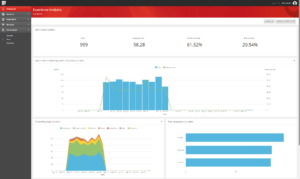Even before COVID-19 hit, Customer Experience – or CX – was already the new battleground for business.
In 2017, the Customer Service Barometer study by American Express found that US consumers were willing to spend 17% more to do business with companies that deliver excellent service, up from 14% in 2014. Moreover, 33% were also willing to consider switching companies after just one instance of poor service. In a post-COVID world, Customer experience (CX) will represent the primary touchpoint between brands and their customers, as well as the key driver of customer satisfaction and loyalty. So clearly, the stakes for getting it right are very high.
As the pandemic rages on, businesses remain vulnerable to dynamic shifts in the market, as well as to technological and operational challenges like performance issues and data breaches. These shifts have shaken customer confidence and generated fear and uncertainty among them. Equally important, they have changed their expectations concerning how brands should engage with them and serve them. So now, more than high-quality products or services, they demand memorable experiences every time they interact with the brand, that connects with their preferred communication channels and marketing touch points.
According to Gartner’s 2019 Customer Experience Management Survey, organizations’ increasing CX budgets indicate their maturity in understanding its potential for delivering powerful business outcomes. But knowing and doing are two completely different things, as several firms are now realizing. So how will they remain competitive in the post-COVID era? And how can they ensure that their CX strategy is well-positioned for success, during and after every crisis?
The Post-pandemic Era: Changing Customer Behaviors and their Impact on Customer Experience (CX)
How has the COVID-19 pandemic changed customer behaviors? More importantly, how has this “new normal” affected brand viability and CX?
More People Are Working From Home Than Ever Before
In the wake of the pandemic, millions of people all over the world are working remotely, dramatically altering the work landscape and the notion of “business as usual” for thousands of organizations. This shift to remote work will stay for the long-term according to this recent Gartner survey. It found that 47% of companies will allow their employees to work from home full-time after the pandemic, while 80% will allow them to do so full-time. And in a PwC CEO Panel Survey, 78% of CEOs agreed that remote collaboration is an enduring shift, not just a short-term trend.
Although remote work enables organizations to maintain business continuity, it also raises several challenges that affect CX. For instance, many of them struggle to share relevant information with customers, especially those that (used to) rely on face-to-face communications or service delivery (e.g. bank branches, insurance offices, or small grocery stores). This directly impacts CX, which in turn lowers customer loyalty and long-term “stickiness”.
Another challenge is that in the remote work scenario, inadequate “in-person” interaction with customers or colleagues, or a lack of clarity from supervisors and managers to mitigate current uncertainties can both take a toll on employees. In particular, it can affect their stress levels, output quality, productivity, and efficiency. And since there is a real and direct link between employee satisfaction and CX satisfaction, unhappy employees lead to unhappy customers and below-par CX.
Finally, more and more customers now expect round-the-clock service coverage, especially during peak periods such as holidays and other business busy seasons. With a virtual team, meeting this need can be easier, but only if the organization has the necessary tools, processes, and workflows in place for seamless remote operations.
The Customer Journey is Changing
In the post-pandemic era, customer journeys are changing across multiple touchpoints. The crisis has greatly affected traditional “brick-and-mortar”, i.e. in-store shopping, so customers are looking for newer communication and service channels to simplify their lives. This is why omnichannel has become a crucial element for CX’s success. Seamless integration between voice, social media, webchat, video, and self-service facilitates quick service and quicker issue resolution, which enables companies to participate in more high-value conversations that strengthen the brand-client relationship.
Since online makes it easier than ever for customers to take their business elsewhere, organizations need to carefully identify and map out new customer journeys, which can show them the way forward to improving customer satisfaction and CX. It’s also important that they keep a real-time pulse on changing customer preferences and introduce innovations to redesign journeys for today’s different context.
At the same time, introducing new touchpoints can impact the whole journey as well. That’s why it’s essential to get a full view of these journeys and understand the broader impacts of even small changes or decisions on CX in these unpredictable times. Moreover, as both work and customer cultures become increasingly virtual, optimizing for the entire journey rather than for a single touchpoint will become even more important.
Customers Expect Personalized CX
A 2018 report from Epsilon revealed that at the time, 80% of customers were more likely to make a purchase when brands provided a personalized experience. In 2020, this KPMG report identifies “personalized, authentic and contextual experiences with a brand” as one of the key “signals of success” for brands in the post-COVID era. In fact, the report found that personalization is the strongest pillar in driving customer loyalty in a majority of markets it surveyed, especially those experiencing severe economic strife. Personalization is also a strong driver of brand advocacy in many markets.
In this scenario, brands must demonstrate that they understand the customer’s specific needs and circumstances, and are willing and able to adapt the experience accordingly. By providing consistently excellent digital services with a human touch, CX leaders can deliver experiences that are more strongly tailored to customers’ circumstances. Thus, they allow customers to take control of their lives and make them feel valued and important, which can all drive long-term customer satisfaction and enhanced CX.
Customer Trust Now Comes at a Premium
Trust has always been an important element of customer-brand interactions. Now it comes at a greater premium since they are questioning whether brands are behaving credibly, and with their best interests in mind during this crisis. Also, at a time when economic stress is front and centre, customers are looking for greater empathy, concern, and care from brands. A majority of them still face challenges due to social distancing, lock downs, and isolation, so a primary barometer of their CX will be how effectively brands can satisfy these needs while maintaining their trustworthy profiles.
Customers are also thinking about other dimensions like safety, community support, and data security, all of which affect their sense of trust and loyalty, and thus their CX. For instance, McKinsey research has found that today, 64% of customers buy from “socially responsible” brands that can make them feel safe in the midst of overwhelming uncertainty. This impacts their long-term CX with the brand, which is why organizations must demonstrate a commitment to their values, purpose, and humanity. They must also innovate their digital models, expand delivery and customer service options, and consider contactless operations. Prioritizing digital security will also be important since the crisis has expanded the cybersecurity threat landscape and made it easier for criminals to steal customer data.
Communication is the Key to Great CX During and After a Crisis
Today’s “connected” customers are impatient, well-informed, and prioritize simplicity and ease of use over brand loyalty. They no longer accept a transaction-only business model, and they don’t appreciate being treated like numbers instead of individuals. They also want streamlined processes, transparency, and speedier decisions over their preferred channels.
So businesses need to understand them better, communicate with them in the right way, and deliver great CX with every interaction. To this end, first, they must take inventory of their customer communications. What is its purpose? Which channels are critical to their customer communications strategy? Which new channels do they need to add to meet customers’ changing needs?
Customers benefit from clear and accurate communications that are frequently updated and delivered promptly. Also, by honestly and adequately informing customers about the scale and severity of potential interruptions to business continuity, brands can keep customers in the loop – which they appreciate – and minimize the impact on their CX during the crisis.
Moreover, modern customer communication should be proactive and two-way “conversations management”, where brands make an effort to solicit input from both potential and current customers. Keeping feedback loops open, transparent, and honest allows customers to give feedback to brands when they have something to say. It also ensures that customers feel comfortable communicating ideas, concerns, and suggestions about their CX expectations and the organization’s shortcomings in this area.
Leveraging Technology to Improve CX
To ensure great CX during and after any crisis, companies must invest in better technology for customer communication management (CCM), customer relationship management (CRM), service delivery, and support. Only then will they be able to deliver a great customer experience and continue to do so, long after the pandemic is over.
For example, the increasing shift towards work from home can be better managed with cloud-based CRM, CCM, and contact center platforms. Such platforms enable teams to collaborate in real-time from anywhere; they also enable companies to engage with customers with the right message, over the right channel and at the right time.
Next, in the post-COVID era, customers want to interact with companies on their terms, regardless of their location or device. That’s why it’s essential to embrace multiple modes of communication, service delivery, and support. This omnichannel strategy should include virtual agents, AI chatbots, and self-service tools that allow the organization to engage customers across the entire lifecycle. With these tools, customer queries can be quickly addressed with minimal delays, and interactions can be personalized based upon each customer’s history and profile. These crucial outcomes can help the brand exceed customer expectations and improve the customer experience over an extended period of time.
A Cloud-based Content Management System (CMS) allows brands to leverage the latest experience management innovations, as well as web analytics, digital asset management, and digital campaign marketing capabilities to design and deliver better CX.
Recommendation engines are also a great technology lever to amplify CX during a crisis. This AI-based tool, commonly used in eCommerce and OTT streaming platforms, offers tailored recommendations to customers to personalize and enhance their CX with the brand. Similarly, an AI-based site search engine enables customers to get to know brands better, and quickly find the exact information they need. When they don’t have to waste time scrambling for information in multiple places, their CX naturally improves.
Technology is the key to delivering a consistent, efficient, omnichannel CX strategy in a post-pandemic world. And a failure to capitalize on its latest developments is a chance squandered that competitors will definitely appreciate and grab for themselves.
Emerge Stronger After Any Crisis with Great CX and WayPath
A global crisis, such as the one we are currently experiencing with COVID-19, tends to reset the priorities and goals of both organizations and their customers. However, a laser focus on Customer Experience (CX) can help you connect meaningfully with your customers and emerge stronger than ever. With the right technology and the right technology partner, you can flourish rather than flounder – crisis or no crisis. You can also expect to generate measurable CX results far into the future with strategic tech implementation in customer communication and customer relationship management. Get in touch with Waypath to know more about our customizable CCM, CRM, and CMSsolutions.




